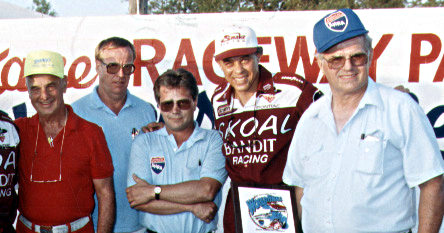 |
Spokane and Orville Moe
 |
| A shot of Orville Moe's Spokane Raceway Park
and a certain wiseacre expressing an opinion on the elapsed times.
The handmade sign adds "clocks." |
Spokane Raceway Park was likely the last brand new state-of-the-art-type
facility that AHRA was involved in before its finish. The track was
top-kicked by Orville Moe, a former racer who was teamed with the first
man over 150-mph, Lloyd Scott, as early as 1957. Today, still in charge
of the Spokane track, he is the only engine with enough whoomph to re-vitalize
another AHRA or its equivalent.
From roughly 1966 through 1969, Moe ran Deer Park Dragstrip in Washington.
He ran into problems with the NHRA on a particular type of race car
he wished to hire in 1969. To greatly shorten the story, Moe wanted
to run jet dragsters after watching the Cogs Car Club successfully run
a show with the cars at another local track. NHRA, which sanctioned
the track at the time, had a standing policy against any member track
running the jets, which forced Moe into a career-changing move.
 |
| Left to right, Vance Brady, Paul Cartwright,
Jim Tice Jr., Don Prudhomme, and Orville Moe at Spokane Raceway
Park. |
He contacted Jim Tice Sr., in Kansas City and told him he wanted to
run the cars and that he knew AHRA had no problem with them. Tice, aware
of his association's Drag World publication schedule, told Moe that
he could be jointly sanctioned and that when he decided to run the cars,
Tice would make an announcement in Drag World that Moe had dropped NHRA
sanction and then run the jets.
The show went off successfully, but because the Deer Park track was
on airport land and new requirements and regulations were constantly
materializing, Moe chose to leave the site. He didn't leave drag racing,
but instead came away wanting to build his own facility. Spokane Raceway
Park was conceived of and designed in 1969 and was finally constructed
in 1974.
"Spokane was probably the first ecologically created track," he said.
"Long before we ever broke ground, we had governmental studies, environmental
impact, stuff like that done, and when we finished the track in early
1974, we had a one of a kind facility. It would seat 40,000 or so people
and had permanent concrete restrooms and concession stands. We held
the Springs race in '74 and it went off well, but it was the only race
we ran that year because there were still other things to do to ready
the track.
"Jim offered us the World Finals race at the beginning of 1975, and
we hosted it in September, but he and I found out that a lot of racers
wanted to hold it in August, when the kids were still out of school."
Tice Sr., and Moe had dinner at a oceanfront restaurant in Washington
and agreed to an August date and the race, AHRA or ADRA World Finals,
has been held there every year since.
Moe's relationship with Tice was similar to Trover's in St. Louis.
The pair of them split everything 50-50 except for the concession (all
of which went to Moe), and the profits from the Washington race proved
to be considerable. Moe wasn't sure of the year, but in either 1978
or 1979, the race had a 100,000 four-day crowd total, on a par with
anything the other two sanctioning bodies enjoyed.
The actual running of the events were consistent with the other tracks.
Tice Sr., would bring in six or seven headquarter officials, like Tech
Director Vance Brady, from the Midwest and they would work with the
local track help and get them squared away for handling 400 to 500 race
cars.
Up until the decade of the eighties, all seemed to be running smoothly
save for the gnaw provided by rivals, NHRA and IHRA.
 |
page 4 of 6
|
|
|